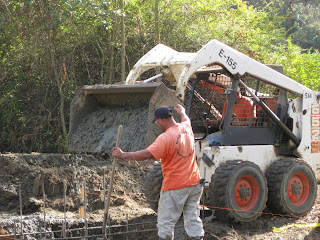On the up side, the dangerously low level of the south lake has been taken care of. Bubalo let water flow into the south lake until it was quite full, then closed up the dam again and pumped the remaining water in the streambed off to the sides of the stream.
As this photo of the dam at the south lake shows, some parts of the stream bank experienced pretty severe erosion. The project team walked the full length of the stream on Thursday to identify erosion and to make sure that those areas are properly addressed as we strengthen the banks over the next couple of weeks.
We also lost some trees in the storms. Above is the large alder that we refer to as the "bee tree." You can just see a brown bat box attached to the trunk closest to the ground (just to the right of where the upper tree crosses over the lower tree). Someone put that bat box up for bats (obviously), but the bees had a different idea. They soon took it over and it has been a bee hive for quite a while. There are so many bees around it that no one is going to remove that bat box. We'll see if the bees abandon it now that it has a new ground-level location. Cuttings from this alder will be used to help strengthen the stream bank where it fell and we expect a small alder grove to grow there in time.
Most of the work this week has been pumping water out of the stream, but Bubalo was also able to do some boulder work at the weir. The boulders being placed in the bank will provide a strong and level surface, allowing visitors to get right up to the edge of the stream without damaging the bank and causing erosion. The weir is also being reworked to allow more flow and to be more aesthetically pleasing.




























